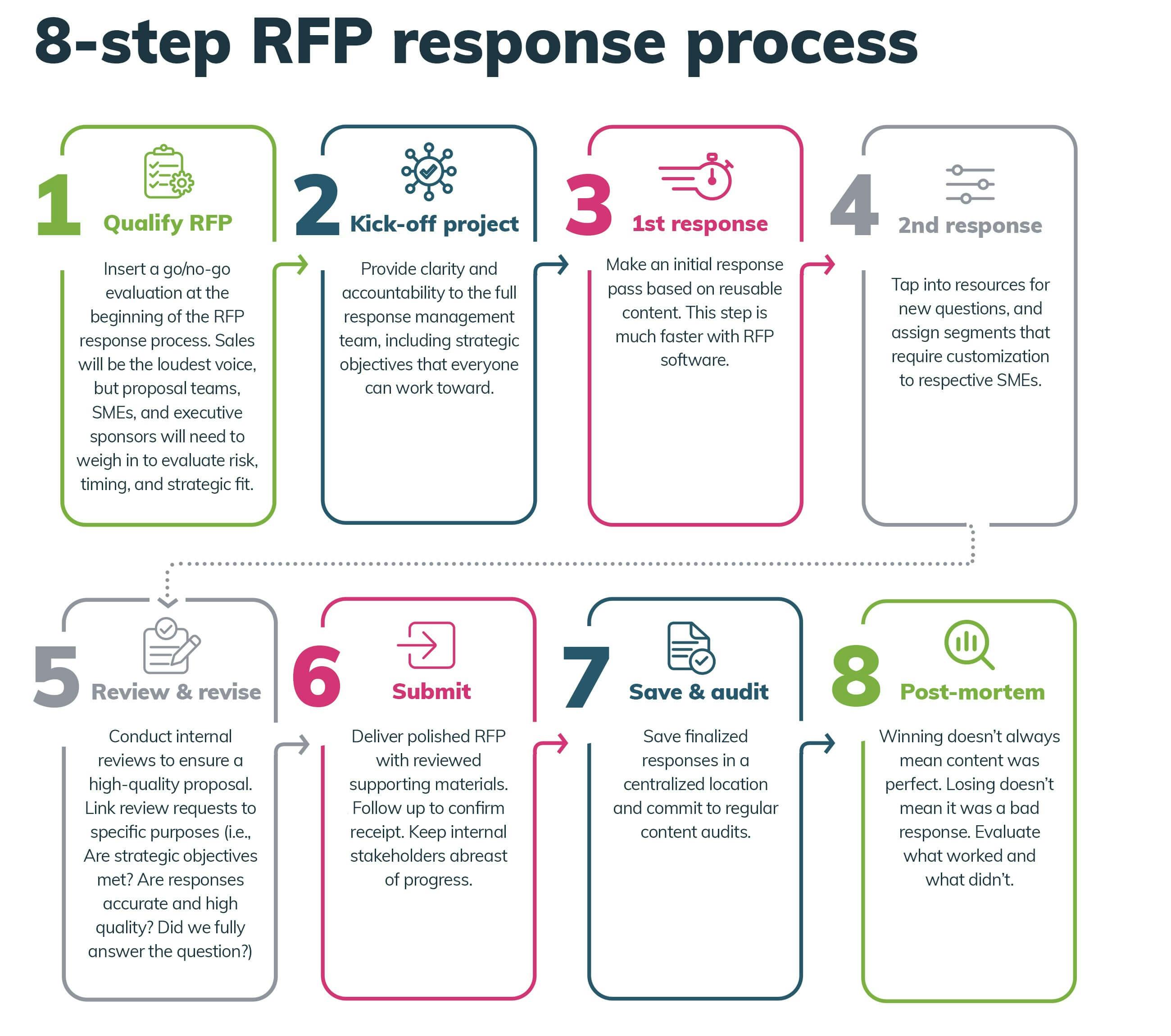If you’re new to the proposal or bid process, then you’ll need the request for proposal (RFP) basics. Even though, like all business processes, the request for proposal process has changed over the years, many of the basics have held true.
This article will brief you on what you need to know about requests for proposals so you’ll be ready to take on the response process with aplomb.
What does RFP stand for?
RFP stands for request for proposal. As a remnant of government contracting processes, it’s no wonder “RFP” is more popular as an acronym. After all, in byzantine bureaucratic processes, responding to an RFP from the DoD is the only way to share your KSP with a VIP who prefers to keep their ID on the QT until they determine ROI. And this all started before texting and social media! LOL!
Why do RFPs exist?
Organizations and agencies issue RFPs as part of their vendor selection process. It’s an attempt to create parameters that enable apples-to-apples comparisons of solutions to a particular problem.
Outside of the United States, RFPs are also known as tenders. Instead of “issuing an RFP,” organizations “run a tender.” Instead of “responding” to an RFP, vendors “bid” on a tender.
Other RFP-related terms
To learn more about common RFP-related terms, you have 3 options. One, check out the quick definitions below (it’ll take less than a minute). Two, read my new screenplay for the short film, “Once Upon a Time in an RFP Process,” later in this article (it’ll take you 3-5 minutes). Three, do both! Note: If you are an artist who can help me storyboard the movie, let’s talk (think low-budget, though).
Proposal
The proposal is your response to an RFP. If an organization or agency asks, “How can I solve X?” in an RFP, then your proposal is the answer: “I propose this solution to X.” Like Dr. Barbay’s single question for Thornton Melon’s academic evaluation that ended up having 27 parts, your RFP proposal can be hundreds, if not thousands of pages long.
RFP Executive Summary
The RFP executive summary sets the tone of the proposal. It’s usually written first, by the salesperson in charge of the relationship. It will summarize the highlights of your proposal. There are occasions when it will be the only part of your proposal that some of the issuing stakeholders will review.
RFI: Request for Information
RFIs, or requests for information, are more casual than a request for quote and more generic than an RFP, RFIs are either a fishing expedition or a clarification exercise.
RFQ: Request for Quote
When someone issues an RFQ, or request for quote, they want you to tell them how much your product or service will cost. Lowest price definitely does not always win. This is an opportunity to illustrate everything included in your offering as well as prospective ROI.
DDQ: Due Diligence Questionnaire
DDQs, or due diligence questionnaires—not to be confused with a security questionnaire (see below)—are all about compliance. You might see one as part of the RFP process, but it’s also likely you’ll be filling these out throughout your partnership with the issuer. With increasing scrutiny on data security and privacy, you may be filling them out more often, too.
Security Questionnaire
This will be one or more standardized questionnaires designed to assess risk of taking you on as a vendor. Popular questionnaires include SIG, SIG-Lite, VSAQ, CAIQ, and more.
When to use an RFP
Say you’re an enterprise or government agency. Through research and experience, you’ve identified five possible vendors that may be able to help solve a particular problem. Now you can issue an RFP to gather everything you need to know about the solution, its cost, and its impact on your operations after selecting a vendor. The level of complexity, number of questions, and deadline will vary greatly depending on your industry and the sophistication of the solution.
When to respond to an RFP
There are several factors to consider when determining whether or not to respond to an RFP. We recommend that your standard RFP intake process include a go/no-go step. Only respond to RFPs that you can win:
- Is the RFP the right fit for your organization and solution?
- Do you have a comprehensive solution that addresses all of the challenges presented in the request?
- Does your pricing match the budget?
- Do you have an existing or prior relationship with the issuing organization?
- Do you have any insight into why the RFP has been issued?
- Can you meet the submission deadline?
When to use RFP software
If you’re responding to a couple of RFPs, a few security questionnaires, and spend most of your time sending out direct responses to RFQs, then RFP software may not be the best fit.
RFP software falls into a new category of software known as response management. Response management software’s primary value is efficiency. How you repurpose time saved will determine much of your success. Some organizations seek to respond to more RFPs, others seek to improve response quality. Most want both.
If you think RFP software and its automation capabilities would help, then it’s important to consider your entire response universe when selecting a vendor. For example, do you only want help responding to RFPs? Or do you want to automate responses to security questionnaires and DDQs, too?
What about proactive proposals? Do your sales, presales, and support teams want a better way to respond to prospects and customers?
RFPs are sales vehicles, and how your organization responds is a sales support function. The response management solution you choose will be determined by how much sales support you want to offer.
What to Look for in an RFP Response Tool
Responding to requests for proposals (RFPs) is often cumbersome and time-consuming, which is why many organizations look for an RFP tool to streamline the response process.RFP tool features >
Sometimes you wonder if life is a movie…
Me, too! So if you had to break down RFP basics into a scene in your life’s movie it might look like…
“Once Upon a Time in an RFP Process”
By Sue Donim
[LOCATION: HOME OFFICE OF “KEYES,” THE SALES MANAGER/PROPOSAL MANAGER/MARKETING MANAGER HERO. KEYES LOGS ONTO A VIDEO CONFERENCE WITH “BOSS.”]
KEYES: Hi, Boss. Nice virtual background. That’s the most artistic rendering of taxidermy I’ve seen in some time.
BOSS: Cut to the chase, Keyes. I’ve grown weary of these online meetings. Unless you have a solution to our revenue and inefficiency challenges, I’d rather you send me an email.
KEYES: You’re in luck, sir. It just so happens that’s why I requested this meeting.
BOSS: That’s what I like about you, Keyes. Always presenting answers instead of complaining about problems. Proceed.
KEYES: We can increase revenue by streamlining our RFP process.
BOSS: Brilliant! I like it…no, I love it! Let’s start immediately. Now…
What is an RFP again?
KEYES: An RFPis a Request for Proposal…when a company needs services and products like ours, they issue an RFP to identify the optimal vendor.
BOSS: Sounds like a no-brainer. Why haven’t we been doing this the whole time?
KEYES: We have responded to RFPs in the past, but it’s not exactly a turnkey process…yet. RFPs can be thousands of pages about pricing, functionality, technology, security, company basics, competitive differentiators, and more. Responding puts a strain on our subject matter experts, sales teams, and anyone else who needs to carve out extra time to help with the process.
BOSS: That doesn’t sound efficient at all.
KEYES: Well, then you have to take into consideration RFIs and RFQs, too.
BOSS: Enough with the acronyms, Keyes.
What’s an RFI? What’s an RFQ?
KEYES: Sorry, Boss. Request for Information and Request for Quote. RFIstend to appear early in the vendor-selection process. Companies issue them to find out if any vendors can help them solve a particular problem. They’re more generic and open-ended and would likely be used to craft a more targeted RFP. RFQs usually show up later in the vendor selection process, usually after we’ve submitted an RFP. This is when the company wants to know specifics on how much our solution will cost.
BOSS: RFPs, RFIs, RFQs… anything else I should know about? Wait, what’s that?!

KEYES: Good eye, Boss. That’s a cheat sheet on writing an executive summary. The executive summary is high-level content that covers the issuer’s challenges and demonstrates how our products and services will help.
BOSS: Sounds like a cover letter.
KEYES: That’s a common misconception, Boss. The executive summary is different from the cover letter. In an executive summary, we provide an executive-level summary of how our solution fixes their problem. In a cover letter, we talk about how great we are.
BOSS: I’m better at that than most.
KEYES: Of course you are.
BOSS: And what do our RFP-winning executive summaries look like?
KEYES: I’ll let you know when we win one.
BOSS: I was afraid you were going to say that.
KEYES: Don’t get discouraged, Boss. I have a plan to turn it around. The right RFP automation software will help us write RFP-winning executive summaries. Just like it will help with DDQs and security questionnaires.
BOSS: What did I just say about acronyms?
What’s a DDQ?
KEYES: Sorry. Last one. The DDQ is the Due Diligence Questionnaire. It’s usually one of the last stages of the response process. In fact, it may come after we’ve already been selected, when the company is doing their final due diligence. It typically involves a few hyper-specific points as part of their standard vendor onboarding protocol.
BOSS: And how is that different from a security questionnaire? In fact….
What even is a security questionnaire?
KEYES: Great question, Boss. Privacy is a hot button, and any company we work with wants to make sure we meet their privacy standards. Security questionnaires generally deal with privacy issues such as compliance, infrastructure security, and data protection. Depending on the company, this questionnaire can be a few hundred or a few thousand questions.
BOSS: Yowza. How long does it take to complete that?
KEYES: Weeks, if we don’t have a response process in place.
BOSS: Excellent. Let’s get it implemented. I’m putting you in charge of it, Keyes.
KEYES: I think that’s a good call, Boss. We’ll start with the 8-step RFP response process.
[CUT TO GRAPHIC OF 8-STEP RFP RESPONSE PROCESS]

BOSS: Looks like I put the right person in charge. You have all the answers, Keyes.
KEYES: Speaking of answers, that reminds of something else that’s essential to a smooth-running RFP process machine.
BOSS: Yes, yes, that’s why I brought it up. What’s on your mind?
KEYES: The Content Library, Boss. It’s the secret to more efficient RFP content management. It’s what makes massive questionnaires answerable in a few clicks. It’s where content is marketing-approved and always ready to share. And if it’s intelligent—as it should be—it’s able to make recommendations along the way so that we can easily customize every RFP response. Plus, once a subject matter expert answers a question it stays in the library forever. From then on, they can take a reviewer role, saving them time and keeping them focused on their primary job duties.
BOSS: That’s it! You’re the winner, Keyes! Best video conference of the day.
KEYES: Thank you, Boss.
BOSS: No, thank YOU! Now, how do we get started. Will you—dare I ask—issue an RFP? Ha!
KEYES: Good one, sir, but no. I already have someone in mind.
[FADE OUT OF VIDEO CONFERENCE CALL AUDIO. ZOOM OUT TO SEE THE BACK OF KEYES. CUT TO BLACK. ROLL CREDITS]
[END]
How is your RFP process performing? Schedule a demo to see how RFPIO can help transform your RFP period piece into an action-packed RFP-process blockbuster.
